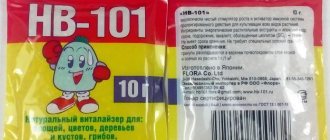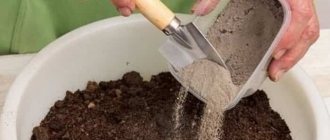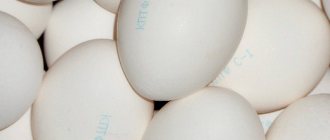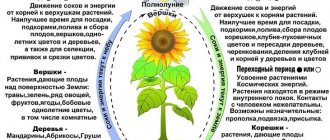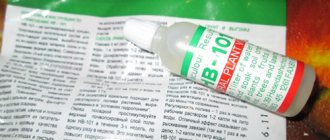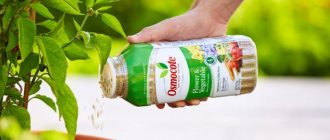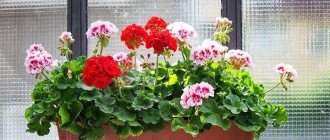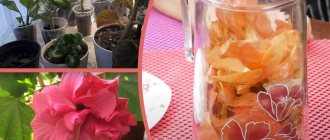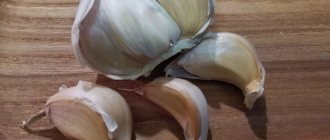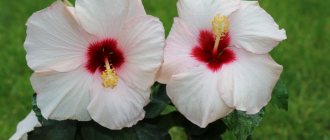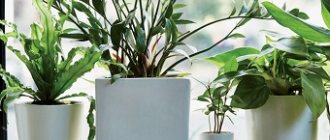Ammonia for indoor flowers - use and dosage
When plants are planted in pots, soil rich in minerals sooner or later loses its beneficial properties, being washed away with each watering, and the flower requires constant feeding for full development.
There are specially developed complexes for certain types of flowers, mineral and organic fertilizers, as well as folk remedies that can extend the life of flowers and improve their appearance. One of the proven inexpensive and accessible means is ammonia, which can be bought in the form of a solution at the pharmacy and successfully used to feed indoor flowers.
Why do midges appear in indoor flowers?
Traditionally, the appearance of foreign animals in flower pots is recorded during the off-season, when flower growers do not have time to readjust and switch to a new regime for watering their pets. As a result, the soil becomes waterlogged, thereby creating ideal conditions for the reproduction of various midges. It should be noted that in most cases, insects interfere with the life of not only the plants themselves, but also their owners, spoiling the appearance of the home and getting into cups and plates.
So, a problem has been discovered - midges have appeared in indoor flowers, what to do and how to get rid of uninvited guests? The fight against them will require the gardener to be systematic, persistent and comprehensive, because even treating the above-ground parts of the plant with insecticides cannot guarantee that there are no pest larvae left in the soil. The main preventive measure against midges in indoor flowers is strict adherence to the drinking regime of plants and avoiding stagnation of water in pots.
Small white midges on indoor flowers
Outwardly resembling a moth, but many times smaller, small white midges on indoor flowers are nothing more than whiteflies. Adults lay eggs on the succulent leaves of domestic plants so that the larvae that hatch from them can feast on the nutritious cell sap without interference. As a result, discolored spots appear on the leaves, the leaves dry out and fall off. Large colonies of whiteflies can devastate an entire home greenhouse in a short time.
Black midges on indoor flowers
Similar to fruit flies, black small midges in indoor flowers are called sciarids or fungus gnats. Their appearance in an apartment is a sure sign that a source of dampness has formed somewhere. Adult sciarids do not harm plants, but their larvae pose a serious threat to flooded and rotting roots. Infection of plants with sciarids can occur either by air or through poorly treated soil.
Flying midges in indoor flowers
It also happens that flower pots become habitats for fruit flies or fruit flies. This is the most harmless type of midge that does not harm either plants or people, causing the latter only psychological discomfort. If fruit flies are infested in an indoor flower, it is necessary to deprive them of all possible sources of food (rotting vegetables, fruits, tea leaves, coffee, etc.), and then destroy all adult individuals using traps or a regular vacuum cleaner.
Soil midge in indoor flowers
Ground flies in indoor flowers are called springtails or springtails. Their body length ranges from 0.2 to 1 mm, and any energizer would envy their activity - most of the day they busily jump from leaf to leaf, scurry along the surface of the soil, populating it with their larvae. If you look closely on the surface of the soil in a pot, you will notice clusters of these small insects.
Adult healthy plants are not afraid of soil midges in indoor flowers. They even play an important role, participating in the process of decomposition of organic matter and saturating the soil with oxygen. Pord larvae living in flower pots, carrying pathogenic fungi and eating up rotten roots, are dangerous only for flooded or diseased flowers.
Characteristics and chemical properties of ammonia
Ammonia is a diluted ammonium hydroxide with varying concentrations of ammonia, the most popular 10% version can be found in any pharmacy, a 25% preparation is also common, but it is sold only in specialized fertilizer stores. At the same time, ammonia is a gas that has a high level of solubility in water, depending on its temperature; as the temperature rises, its solubility decreases.
This drug is a transparent, liquid solution that has a specific odor of ammonia, unpleasant for people and animals. From the point of view of chemical composition, this is a very simple concentrate; people call it ammonia.
Gardeners use the term ammonia as an analogue to ammonia, even though their actual chemical formulas are different.
This substance is used in the following areas:
Using ammonia for indoor plants
An affordable and cheap option for nitrogen fertilizer can confidently be called ammonium solution, which is sold in pharmacies and specialty stores. Since all flowers need nitrogen directly from the soil, they need such fertilizing for normal development. When using ammonia as a fertilizer, plants quickly receive the nitrogen necessary for the production of chlorophyll, since the product is immediately absorbed without additional processing.
Ammonia is widely used by gardeners in the form of a mixture of different concentrations; it is perfect for the following flowers:
The second widespread use of this substance among amateur gardeners is its use to increase the resistance of plants to various pests and diseases, since ammonia liquid has a positive effect in the fight against various pests and diseases.
Preventing the appearance of midges in flower pots
Adjust proper watering habits
Midges feel comfortable in moist soil; eggs and larvae cannot survive without a constant moist environment. Most likely, your plant can do well if you water it less. Try testing the soil with your finger and watering only when it is completely dry, at least 2-3 cm. A moisture sensor can help in this case.
Consider Drainage and Humidity
The level of soil moisture depends on whether the pot with soil has special drainage. Not all plants and flowers are suitable for highly moist soil. The filler for a pot for indoor flowers requires 15% air, 35% moisture and 50% soil. And here you can’t do without drainage, which creates comfortable conditions for the greenhouse. Too much moisture displaces 15% of the oxygen needed by plants. Drainage is necessary because this is the only way unnecessary liquid can escape and the roots of the plant can breathe. If using a tray under the flowerpot, empty the tray immediately after watering to prevent moisture buildup and black flies.
White midges in indoor flowers
Use the right soil
Well-prepared soil contains slow-decomposing organic materials such as coconuts, fibers and charcoal. On the inorganic side, perlite is also a good ingredient. Use well-draining soil that decomposes slowly; The more old the plant's environment, the more attractive it is to pests.
Also, don't reuse soil when you repot the plant; It's better to have fresh soil every time.
Pruning as a means of controlling midges
Promptly trim dying or dead foliage from the plant, especially in areas close to the soil line. The less organic material decomposes, the less midges there will be in the pot.
Do not replant the flower in a large pot
The more land that is watered to feed the flower, the more space there is for earth parasites in the accumulated moisture.
Preparation of solution and calculation of dosage for flowers
In order to help indoor flowers, it is important to correctly calculate the required amount of any fertilizer so as not to spoil the flowers. The same applies to ammonium solution. It can be used for three main purposes:
Options for the required concentrate depending on the expected result:
The proposed options for preparing a nitrogen product for plants are universal. It is important to take into account the size of the pot and the flower itself when watering or spraying with a solution.
What are the benefits of nitrogenous compounds?
Ammonia is a clear white liquid with a pungent odor; it is widely used for household and medical needs. Ammonium solution or in other words ammonia tincture. Many gardeners use ammonia as a fertilizer for indoor flowers, garden and vegetable plants. This chemical compound can serve as a good source of nitrogen for plants.
Nitrogen is one of the most important elements for plants. It promotes the process of photosynthesis. If there is a lack of nitrogen in the soil, the production of chlorophyll is disrupted and plant diseases - chlorosis - appear. The leaves lose color, turn yellow and become discolored. Over time, the leaves die, buds and flowers fall off. The plant may die.
Fertilization with nitrogen compounds promotes the growth of leaves and stems. The plant acquires a rich, rich green color. Nitrogen is necessary for all living crops; the only difference is in the amount of the element consumed.
Rules for using the drug for indoor plants
It is best to use ammonia in order to replenish nitrogen losses, “invigorate” deciduous plants during the period of their active growth and improve flowering when buds appear, but this type of organic fertilizer should not be used for constant feeding of plants.
Spraying foliage
When using an ammonia mixture, do not allow it to come into contact with the leaves of indoor flowers, as it can cause burns to the flowers. If this happens, then you should rinse the plants from the sprayer with running water to remove any remaining ammonia.
Pest protection
To prevent the appearance of pests, you can water the plant at the foot with a universal solution of ammonia and water immediately after planting; this procedure will create additional disinfection of the soil.
If insects appear and need treatment, it is enough to use one of the product options once every 7 days.
Usually it is enough to carry out 1-2 such procedures to get rid of insects; if necessary, you need to repeat watering until the flowers are completely recovered. However, you should not carry out treatment more than once a week or increase the concentration of ammonia in the water for irrigation, as this can lead to the destruction of decorative greenery.
Root feeding
The most common way to use ammonia is to fertilize flowers. Root watering is excellent for indoor plants. Its use is appropriate during the period of active flower growth during March-September. At this time, it is enough to feed the flowers once or twice a month, if they do not show signs of nitrogen deficiency.
What plants benefit from ammonia?
Ammonia is a universal fertilizer; it is suitable for all garden and flower crops. But different plants absorb ammonia nitrogen differently.
For seedlings
Seedlings love to “eat” such nitrogen.
Weekly root feeding with a solution of ammonia (1 teaspoon per 1 liter of water):
- strengthen young growth;
- stimulate growth;
- facilitate the stage of transplantation into open ground.
In addition, the sprouts develop protective properties against diseases and pests. Containers can be treated with this solution before planting to neutralize them from microorganisms.
For cucumbers
Cucumbers will delight you with a rich harvest if you regularly pamper them with nitrogen fertilizers. You need to start adding them when the shoots begin to grow. Gradually, the frequency should increase from 1 time per week to 1 time every 3-4 days. They are especially justified during the formation of the ovary.
Over time, the concentration of ammonia should also increase from 0.5 tsp to 1 tsp per 1.5 l of water.
For tomatoes
Tomatoes should be fertilized with ammonia only if the plant is weakened or the growth of the bush is delayed.
A few feedings with 0.5 tbsp will be enough. l per 1 liter of water at intervals of seven days. They should be abandoned if the plant’s condition has noticeably improved. You can return to them again in the fall, when the first cold does not allow the fruits to ripen. Spraying (10 ml of ammonia per 10 liters of water) accelerates ripening.
For strawberries
Strawberries do not absorb ammonia nitrogen well. More treatments are carried out to protect against pests and diseases. 2-3 times per summer is enough.
As soon as the first leaves appear, pour a solution of 40 ml of ammonia and 10 liters of water generously onto each bush. This will destroy pests that have overwintered in the soil.
Using the same ratio of components, apply the treatment after harvesting. This measure will prepare the plant for winter.
You can water it with fertilizers immediately after flowering, using a solution with a lower concentration of ammonia (dilute 30 ml per 10 liters of liquid).
For onions and garlic
Onions and garlic respond well to foliar feeding with ammonia. To do this, use a solution of 10 liters of water and 3 tbsp. l of ammonia, generously spray the leaves. The procedure must be continued until the signs of chlorosis – yellow, curled feathers – completely disappear. This procedure will prevent the appearance of onion flies.
For cabbage
Cabbage has a high nitrogen requirement. It absorbs ammonia nitrogen better than organic nitrogen. The first application of fertilizer can be combined with planting. Add half a liter of 1% solution to each well. To do this, 10 ml of ammonia is mixed with 10 liters of water.
This procedure will simultaneously repel earth pests. Next, you should do regular feeding at intervals of 10-14 days.
When a head of cabbage forms, you can water it from a watering can or spray it with a solution of 100 ml of ammonia per 10 liters of water. This will help if there is a fight against slugs and caterpillars.
For garden flowers
Fertilizing flowers with ammonia is most useful for bulbous plants, as well as for clematis, zinnias, roses and peonies.
It is recommended to carry them out several times over the summer, alternating root and foliar feeding:
- solution for spraying on leaves - 1 tsp per 1 liter of water
- irrigation solution – 25 ml per 10 l.
Feeding is mandatory during the period of appearance of the first leaves and budding. Perennials can be fertilized after flowering in preparation for winter.
For indoor plants
For indoor plants you need to make a weak solution (1 tbsp per 3 waters). It can be watered or sprayed on the leaf. If these are decorative deciduous crops, then fertilizing is useful throughout the entire period of active growth until autumn.
Flowering indoor plants are fertilized until buds form, after which they should be discarded.
An exception is geranium, whose leaves turn yellow with minimal nitrogen deficiency. She is fed regularly. Do the same if you grow homemade lemon. If there is a lack of nitrogen in the soil, the ovary will not form.
When using ammonia as a fertilizer on any plant, adhere to the following rules:
- do not use ammonia in parallel with other nitrogen fertilizers;
- start with low concentrated solutions;
- do not use more than once a week.
Safety when using ammonia
Ammonia solution is a toxic substance even at a low concentration of 10%, so it is very important to follow safety rules when working with the substance in order to protect yourself and plants from the damage it can cause.
For a plant
When working with flowers, it is very important not to use excessive doses of ammonia, which harms the flowers by deteriorating the quality of the soil. It is necessary to calculate the required amount of concentrate for irrigation, avoiding its contact with foliage.
It is also not recommended to prepare this mixture for several weeks; it should be used immediately to preserve minerals.
It is important to adhere to the recommended feeding regimen, since shortening the interval between watering will not benefit the flowers, but rather, on the contrary, will lead to rotting of the root system. In this case, you cannot use the ammonium solution simultaneously with other nitrogen fertilizers.
For man
Ammonia vapors can seriously harm human health and cause poisoning or an allergic reaction, so it is important to adhere to the following rules when working with the substance:
These rules should not be ignored even if you need to prepare a small amount of liquid for irrigation, which, if it comes into contact with the skin, causes burns, as well as disruption of the mucous membranes and respiratory tract.
Common Questions
Having noticed such conditions, you should pay attention to nitrogen fertilizers and apply them.
A solution of ammonia is a universal remedy that helps replenish nitrogen deficiency in indoor plants, and also allows for the prevention of their diseases. You should not get carried away with this product as the only option for improving the condition of flowers, because in some cases it can harm plants and the human body if the rules for working with it are not followed.
Source
Ammonia for flowers: benefits and methods of use
Ammonia is a popular pharmaceutical drug widely used in medicine and everyday life. It is also useful for plants, including flowers. We will consider the features of using such a tool below.
Beneficial features
Ammonia is a transparent substance with a very pungent and pungent odor. This smell is provided by ammonia, and most often its concentration is 10%. A similar composition can be purchased at any pharmacy. There is also ammonia with a 25 percent concentration, but such preparations are rare. Ammonia gained popularity in gardening due to its high nitrogen content.
This substance is extremely important for all plants, as it allows them to grow green mass in the shortest possible time.
Here are some useful properties of ammonia:
Gardeners also love ammonia because such fertilizing is absorbed by plants exactly as much as needed. This is very important, because excess nitrogen causes the plant to spend all its energy on mass growth, and there is no energy left for flowers, ovaries, and fruits. This will not happen with ammonia, but remember that if you give too much concentration, the roots of the plant may get burned.
How to divorce?
Although ammonia is a relatively safe product, it must be diluted correctly, observing the recommended proportions and dosage.
Let's consider the most popular solution used to fertilize flower crops:
This relatively weak solution is well suited for indoor flowers and garden plants . Helpful advice: if you need to spill only 1 flower with the solution, it is not at all necessary to make 3 liters of the composition at once. You can take 1 liter of water and combine it with a teaspoon of ammonia.
By the way, deciduous house plants can be watered with a stronger composition: 2 teaspoons per liter of water or two tablespoons per 3 liters.
Plant species favored by pests
Qualified florists know not only how to get rid of midges, but also which plants are most threatened by such an attack. Springtails choose plants with soft leaves (primrose, azalea, begonia). Sciarides attack any houseplant without any problems, but most often violets (Saintpaulias) suffer from them.
Removing midges from flower pots is not always easy, but it is possible . The problem should be solved comprehensively and carefully. First of all, you should understand the reason for their appearance.
You will have to treat not only obviously infected plants, but also others that are in the house. During the fight, attention is paid to both adult midges and their offspring.
How to use?
Ammonia can be used in different cases, but mostly gardeners are limited to only two options.
Top dressing
The use of ammonia will give the best results in case of nitrogen starvation of the crop. This manifests itself as follows:
To make up for the lack of a useful element and allow the plant to gain weight faster, they begin to water it with a weak solution of ammonia, the preparation features of which we have already examined. If everything is fine and you have seen the first results, then you can slightly increase the concentration of ammonia, for example, instead of 1 tablespoon, put 2. But this is the maximum allowable amount. Feeding should be done once every two weeks throughout the entire growing season and flowering period; the amount of liquid is individual for each flower specimen and depends on its type . If regular watering takes a liter of water, then you also need to feed with a liter, only this time with a solution.
It is very important not to flood the plant. If you follow the rule “more is better,” you can ensure that the roots begin to rot.
And moist soil will create an excellent environment for fungal carriers. But if everything is done correctly, the plants will delight gardeners with their healthy and lush appearance. Plants such as geranium, rose, lily, violet, and nasturtium respond especially well to ammonia fertilizing. But crops such as lithops are prohibited from being treated with ammonia. The same applies to “living stones”.
Pest control solution
Ammonia can be used to spray flower crops. However, this is not done for feeding, but to get rid of pests. Moreover, experienced gardeners recommend spraying only for plants growing in open ground. With the help of a properly prepared composition, you can get rid of pests such as midges, thrips, aphids, flies, snails and slugs, mole crickets, all kinds of caterpillars and butterflies.
The preparation of the solution is as follows:
The finished composition is poured into a spray bottle and the flower crops are processed. It is important that the healing solution gets on all parts: stems, leaves, twigs . You also need to make sure that the lower part of the leaf blade is treated, because this is where aphids most often nest. Several such treatments and the insects, frightened by the pungent odor, will leave your area. Wasps and other flying insects disappear especially quickly. The aphids quickly die, since the soap in the composition forces them to stick to the leaves and suffocate.
Now let's look at the concentration of solutions for other types of insects.
Disinfection of pots
Ammonia can also be used to disinfect containers intended for planting indoor flowers. To do this, grate 100 grams of solid laundry soap and then dilute it in 5 liters of hot water. 60 milliliters of ammonia are poured into this mixture. Immediately wash the pots, then rinse and set out to dry in the sun. This simple procedure will protect you from many diseases and pests.
Finally, we’ll give some more useful tips about using ammonia on flowers:
How to dilute ammonia from pests
Aphids are a terrible evil for almost all plants in the garden. There are about 1.5 thousand representatives of a dangerous pest that can ruin the entire harvest of currants, gooseberries, apple trees, cherries, strawberries, grapes, many vegetables (cabbage, cucumbers, carrots, tomatoes) and flower crops (roses, clematis) and many others crops
Insects feed on the sap of young leaves and shoots, causing their dehydration and subsequent death. A sweet sticky coating appears on the leaves, causing fungal infections. In addition, this plaque attracts ants, which then become carriers of fungal infections and the same aphids.
Sometimes gardeners have to make a lot of effort to get rid of both aphids and ants. One way to combat them is to spray with a solution of ammonia. To do this, as soon as the snow melts, before flowering begins, you need to generously spray the plants with the following composition:
- liquid green soap - 3 tbsp. l.,
- 10% ammonia solution – 1.5-2 tbsp. l.
Mix the ingredients and spray the leaves very generously on all sides using a fine spray, literally washing off the insects. Carry out the treatment every 1.5-2 weeks 3 times. Have time to do this before the plants start flowering.
And for ants, make a mixture of green soap, vinegar and vegetable oil, and pour this mixture onto the soil around the bushes and trees.
Fighting mole crickets with ammonia is an old, proven method. The principle of operation is that the pest does not tolerate strong odors and leaves these places. To prepare the solution, dissolve 3 tbsp in 10 liters of water. l. 10% ammonia solution (or 10 ml). The working solution is watered between the rows. The dosage must be strictly observed, otherwise the plant itself can be harmed.
You can moisten rags with a concentrated (10%) solution and stick them into the passages where the mole cricket lives. And so that the smell does not dissipate for a long time, the rags can be put in a plastic bag, pierced several holes in it and placed in the tunnels.
Safety regulations
Ammonia has a sharp and very pungent odor, so when using it it is necessary to protect your respiratory system. When working with the substance, you must remember to wear a mask or respirator. It is very important to wear gloves as well as goggles. The product must not come into contact with the skin.
Here are some more recommendations:
How to feed flowers with ammonia, see the following video.
Source
How to get rid of black midges using improvised means
Start fighting black midges as soon as possible. And with both adults and larvae.
Carefully inspect the soil in the pot. If there are a lot of larvae in it, do not take risks and simply replant the plant in new soil.
Cluster of black midge larvae
If there are few larvae, treat the soil using one of the methods listed above.
Potassium permangantsovka
Instead of regular water, water the plant 1-2 times with a light pink solution of potassium permanganate.
Matches
Take a few matches and insert their heads into the ground near the edge of the pot, away from the flower itself.
After the second watering, the matches can be removed: all the sulfur has been washed away from them. If the larvae survive, repeat the procedure.
Repellent scents
Place a piece of orange peel or a clove of garlic on the soil in the pot. Just remember to replace the scent after a couple of days to prevent rotting.
find out

